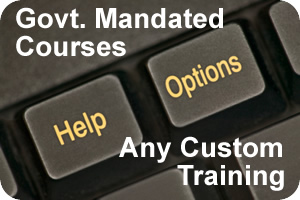|
|
Building Online Training - Start HereA flexible, all-in-one Learning Management System can empower the staff and external partners at a company or organization, with significant knowledge transfer, and low costs Build your online training with our LMS - FlexTraining. It provides a proven strategic advantage in a competitive marketplace. It gives you immediate feedback, a proven path to project success, and the ability to quickly accomplish knowledge transfer. |
Technical / Software SupportFlexTraining software is very easy to install and configure, relative to traditional mainframe and LAN-based applications. FlexTraining also includes 30 days of Phone and E-mail based support, in case there are installation questions or issues with the construction of your first few courses. (We suggest using e-mail as a primary communication vehicle for support questions, since details are automatically documented). Unlike many software companies, we do not “contract out” our technical support function to a third party, domestic or overseas. Instead, we use our own development team for technical support. When you write or call with a software issue, you’ll be talking to someone who works with FlexTraining every day. We will normally respond to any issues you e-mail or call us with, within one working day, and often within an hour. We intend to support you at a level sufficient to insure that your training project is a success. FlexTraining software is so well designed and reliable that we average less than one call every six months per customer! |
Management Center ModuleThe Management Center Module lets you define and schedule courses, control and monitor training activity, and manage your operating environment, without programming or performing complex setup tasks on the server. Through its simple, secure, web-based menu you can:
|
Instructor CapabilitiesAssigning an instructor, usually a subject matter expert, is done at your discretion. You decide, on a class-by-class basis, whether an instructor will be used. If you assign an instructor, he or she will use the Instructor Module to:
Instructors may also access a “Teacher’s Lounge” facility designed to promote knowledge sharing and collaboration amongst faculty. In the lounge, instructors can:
|
Student ModuleThis web-based module lets your online learners:
|
Installation and Management GuideFlexTraining comes with an Installation and Management Guide, which covers the initial setup, and ongoing operation, of the system. It includes instructions on how to assemble and schedule each course, and how to manage and monitor ongoing training. In addition, Help demos are always available from the Student Menu home page. |
System SecurityFlexTraining provides the proper level of security for each of the software modules. For the Management Center module, you will utilize native Windows security, which means that your internal Authorization Lists are used to permit or deny access to the FlexTraining menu. Since each FlexTraining module is defined as a separate application, access to each may be easily limited to different users and User Groups. For example, you may decide to limit access to the Management Center Module to one or two Course Designers and Administrators. The FlexTraining Student Module and Instructor Module provide more detailed security, with database-resident user lists and passwords for Students and Instructors. Each student can only sign on to the courses in which they are registered, and each Instructor may only sign on to the course for which he or she is the designated Instructor. |
How online training really worksA company may decide they desire to have their employees accomplish certain online training objectives. They may send a low-level manager or evan a training manager onto the web to find a vendor who provides online classes covering a certain topic. The manager may find a training site offerring classes that are available, and that cover the general subject that is targeted. However, what she may eventually discover is that there are really no pre-built courses that exactly cover the material that the employees need to be trained on. As a result, the company will realize that it actually needs to acquire an authoring and delivery framework so that it can create and manage the courses exactly as needed. This framework, called a Learning Management System, is acquired as either a server-based software product or an annual subscription. |
Using the FlexTraining LMSDeveloping online training, once a Learning Management System is in place, proceeds in three general steps:
|
|
Choosing the right web based training solution provides a complete framework and delivery system to develop, assemble and manage an online training program. E-Learning will transform or augment your traditional classroom training program and provide access to learners throughout your organization and/or customer base. Be sure your online training system is cost-effective and compatible with your technical environment, and that it meets the scale of your learning initiatives. For administrators, instructors and students, all the components of your E-Learning software should be the right fit. |
 © 2017 National Training Systems, Inc.
© 2017 National Training Systems, Inc.

